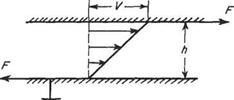Viscosity
Viscosity is regarded as the tendency of a fluid to resist sliding between layers or, more rigorously, a rate of change of shear strain. There is very little resistance to the movement of a knife-blade edge-on through air, but to produce the same motion through thick oil needs much more effort. This is because the viscosity of oil is high compared with that of air.
Dynamic viscosity
The dynamic (more properly called the coefficient of dynamic, or absolute, viscosity) viscosity is a direct measure of the viscosity of a fluid. Consider two parallel flat plates placed a distance h apart, the space between them being filled with fluid. One plate is held fixed and the other is moved in its own plane at a speed V (see Fig. 1.3). The fluid immediately adjacent to each plate will move with that plate, i. e. there is no slip. Thus the fluid in contact with the lower plate will be at rest, while that in contact with the upper plate will be moving with speed V. Between the plates the speed of the fluid will vary linearly as shown in Fig. 1.3, in the absence of other influences. As a direct result of viscosity a force F has to be applied to each plate to maintain the motion, the fluid tending to retard the moving plate and to drag the fixed plate to the right. If the area of fluid in contact with each plate is A, the shear stress is F/A. The rate of shear strain caused by the upper plate sliding over the lower is Vfh.
These quantities are connected by Newton’s equation, which serves to define the dynamic viscosity ц. This equation is
|
|
Hence
[ML-‘T-2] – MfLT-‘L-1] = МГГ-1]
Thus
M = [ML-‘T-1]
and the units of ц are therefore kgm-1 s-1; in the SI system the name Poiseuille (PI) has been given to this combination of fundamental units. At 0°C (273 K) the dynamic viscosity for dry air is 1.714 x 1 O’5kgm-1 s-1.
The relationship of Eqn (1.5) with ц constant does not apply for all fluids. For an important class of fluids, which includes blood, some oils and some paints, ц is not constant but is a function of Vfh, i. e. the rate at which the fluid is shearing.
Kinematic viscosity
The kinematic viscosity (or, more properly, coefficient of kinematic viscosity) is a convenient form in which the viscosity of a fluid may be expressed. It is formed
|
|
Fig. 1.3
dynamic viscosity p according to the
 -t
-t
P
and has the dimensions L2T-1 and the units m2 s_1.
It may be regarded as a measure of the relative magnitudes of viscosity and inertia of the fluid and has the practical advantage, in calculations, of replacing two values representing p and p by a single value.












